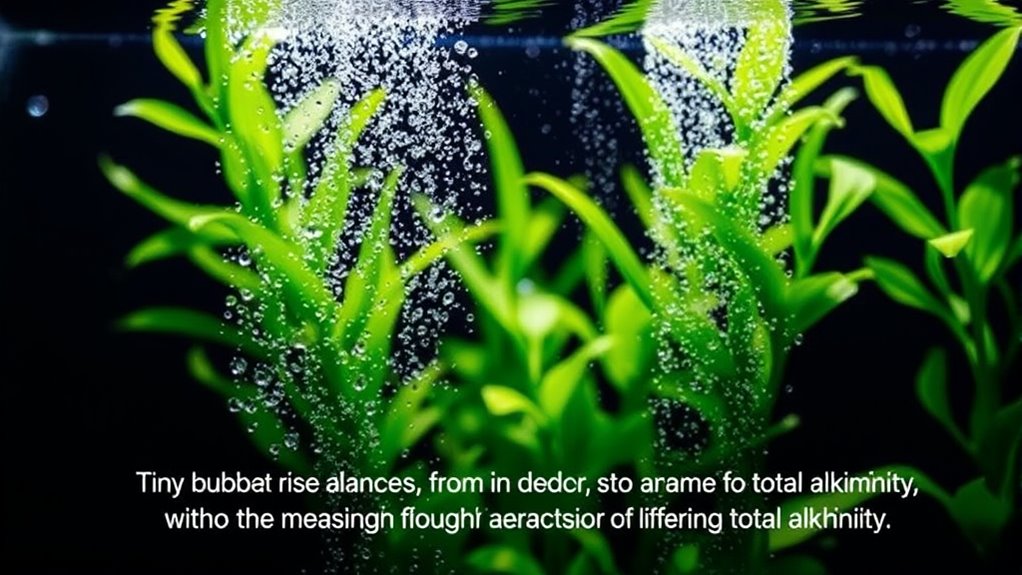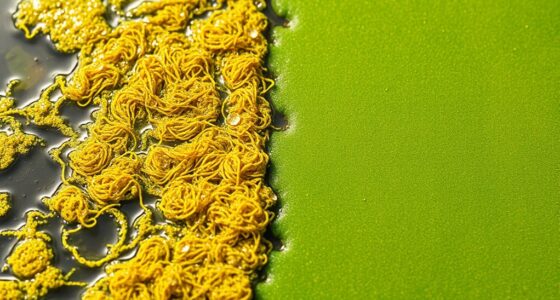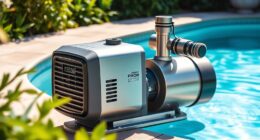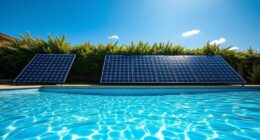To raise pH without increasing total alkalinity, you can use aeration, which naturally removes CO₂ from water. As CO₂ escapes, the pH climbs because there’s less acid to keep it low. Unlike chemical adjustments, aeration doesn’t add carbonate ions, so TA stays stable. Proper aeration equipment like diffusers and consistent operation help achieve this gradual pH increase. Keep exploring to discover detailed tips for successful application.
Key Takeaways
- Aeration removes CO₂ from water, raising pH without significantly affecting total alkalinity.
- Introducing oxygen bubbles accelerates gas exchange, stabilizing pH independently of alkalinity levels.
- Proper aeration techniques prevent rapid pH shifts, maintaining stability without increasing TA.
- Regular monitoring ensures pH rises gradually during aeration, avoiding overcorrection.
- Aeration enhances oxygen levels and organic waste breakdown, supporting stable water chemistry without altering TA.
Understanding the Relationship Between Ph and Total Alkalinity
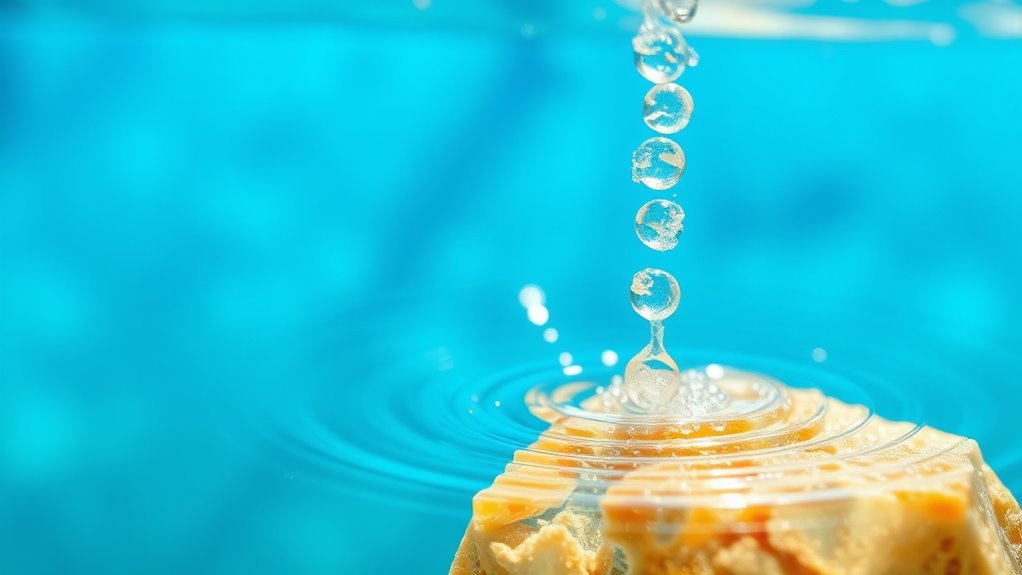
Understanding the relationship between pH and total alkalinity is essential for effective water chemistry management. Your pH measures how acidic or alkaline your water is, while total alkalinity indicates the water’s capacity to neutralize acids. They are connected but not the same. High alkalinity buffers pH changes, preventing sudden shifts, but raising alkalinity doesn’t automatically raise pH. Conversely, lowering alkalinity can cause pH to fluctuate more easily. If you want to adjust pH without impacting alkalinity, you need to understand this balance. Aeration, for example, can help increase pH by removing carbon dioxide, which affects pH levels without profoundly altering alkalinity. Managing both parameters carefully ensures stable water chemistry, avoiding issues like corrosion or scaling. Additionally, understanding how headphone jacks work can be useful for troubleshooting audio equipment used during water testing or monitoring.
The Science Behind Oxygen’s Effect on Water Chemistry
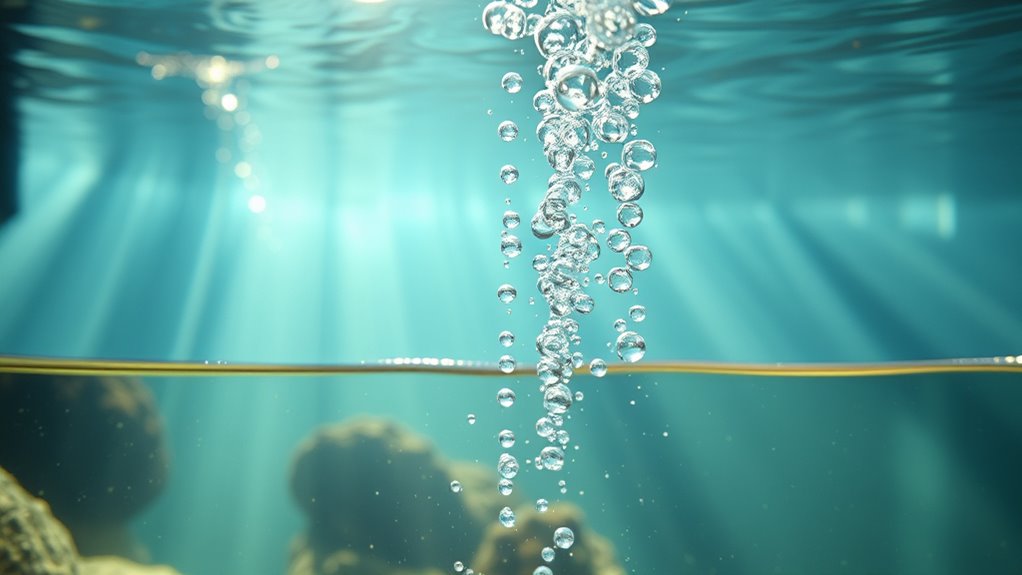
Oxygen plays a key role in balancing your water’s pH levels by influencing chemical reactions. When you aerate, you increase dissolved oxygen, which can help stabilize water chemistry. Understanding how oxygen affects these processes can help you maintain a healthier, more stable pool environment. Additionally, proper aeration techniques can improve indoor air quality by reducing pollutants and allergens, leading to a more comfortable living space.
Oxygen and Ph Balance
While oxygen may seem like just another element in water chemistry, it actually plays a crucial role in maintaining pH balance. When you introduce oxygen through aeration, it helps convert dissolved carbon dioxide into bicarbonates and carbonates, which can stabilize pH levels. Increased oxygen levels encourage the chemical reactions that reduce carbonic acid, a primary factor in lowering pH. This process makes water less acidic without markedly affecting total alkalinity. Essentially, by increasing oxygen, you’re shifting the equilibrium toward less acidic conditions, helping raise pH naturally. This balancing act improves water quality and creates a healthier environment for aquatic life. Additionally, proper oxygenation can influence other aspects of water chemistry, supporting overall water quality management. Remember, maintaining proper oxygen levels can be a subtle but powerful way to control pH without altering other chemistry parameters.
Aeration Increases Dissolved Oxygen
Aeration directly increases the amount of dissolved oxygen in water by introducing air or pure oxygen into the system. When air bubbles rise through the water, oxygen molecules transfer from the bubbles into the water, raising the overall dissolved oxygen levels. This process is driven by the natural diffusion of gases, which depends on the concentration gradient between the air and the water. The more aeration you perform, the more oxygen dissolves into the water, supporting healthy aquatic environments and improving water chemistry. Increased dissolved oxygen helps microorganisms break down organic matter more efficiently and maintains stable pH levels. Proper aeration can also prevent the buildup of harmful pests and fungi that affect aquatic plants. By effectively aerating your water, you ensure that oxygen levels are sufficient to promote a balanced and healthy aquatic ecosystem.
Water Chemistry Stabilization
When dissolved oxygen levels rise in your water, they directly influence the stability of its chemistry. Increased oxygen helps prevent the buildup of harmful compounds like carbon dioxide and organic acids, which can lower pH over time. By boosting oxygen, you promote a more balanced environment, reducing the likelihood of pH swings. This stabilization occurs because oxygen drives the oxidation of organic matter, breaking it down into less harmful substances and preventing acid formation. Additionally, higher oxygen levels support beneficial bacteria that maintain water quality naturally. As a result, your water remains more consistent in pH, making it easier to manage other chemistry parameters. Proper aeration, hence, not only raises pH but also stabilizes overall water chemistry, creating a healthier aquatic environment. Moreover, understanding the importance of divorce statistics and legal resources can help individuals navigate complex processes effectively, much like maintaining water stability requires knowledge and proper tools.
Why Raising Ph Often Comes With Increased TA
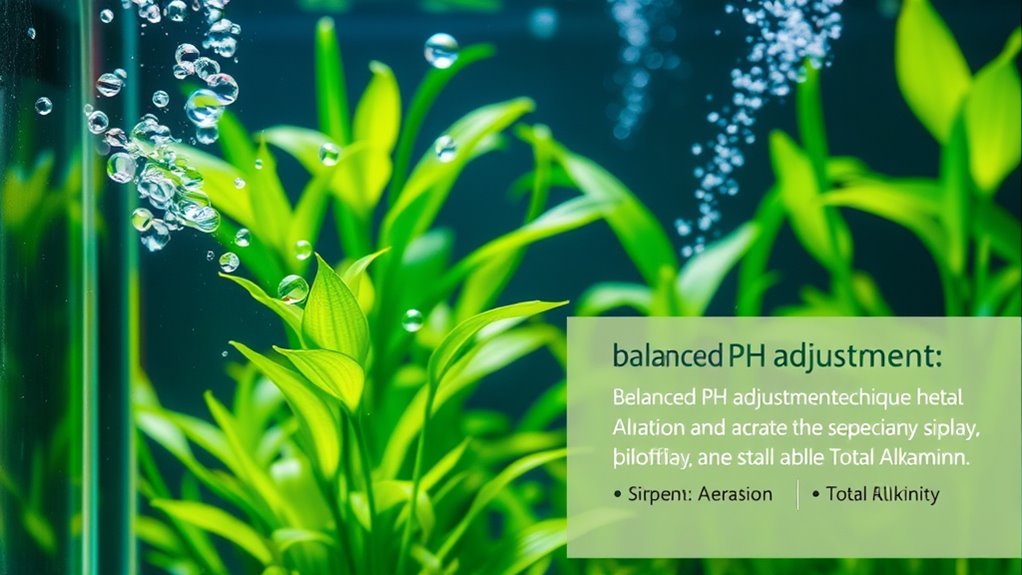
When you raise the pH of your water, chemical changes during aeration can cause the total alkalinity (TA) to increase. This happens because aeration often releases carbon dioxide, shifting the water’s balance and raising both pH and TA. Understanding how these factors interact helps you manage your water chemistry more effectively.
Chemical Changes During Aeration
As you introduce aeration to raise your pool’s pH, chemical reactions in the water drive shifts in carbonate equilibrium that often lead to increased total alkalinity (TA). When air bubbles dissolve into the water, they remove carbon dioxide (CO₂), which shifts the equilibrium toward carbonate ions. This process causes the pH to rise but also increases TA because the water contains more buffering capacity. You might notice these effects:
- CO₂ escapes as bubbles, reducing acidity
- Carbonate ions become more prevalent
- pH increases without adding chemicals
- TA appears to rise naturally
- The balance between carbon dioxide and carbonate shifts
Understanding these changes helps you realize why aeration can raise pH while also increasing TA, often unexpectedly.
Balance Between Ph and TA
Raising your pool’s pH often leads to an increase in total alkalinity (TA) because of the chemical shifts that occur during aeration. When you aerate, dissolved carbon dioxide escapes, causing the pH to rise. However, this process also shifts the carbonate equilibrium, resulting in higher TA levels. To understand this balance, consider how different chemicals affect pH and TA:
| Effect | Result |
|---|---|
| Aeration | Raises pH and TA |
| Adding acid | Lowers both pH and TA |
| Baking soda (sodium bicarbonate) | Raises TA more than pH |
| pH adjusters (pH Up) | Raises pH, increases TA slightly |
| Acid injection | Lowers pH, reduces TA |
Knowing how chemicals interact helps you manage pH and TA effectively without unintended increases. Additionally, understanding the chemistry behind chemical interactions can help optimize your pool maintenance strategy.
How Aeration Alters Water Ph Through Gas Exchange
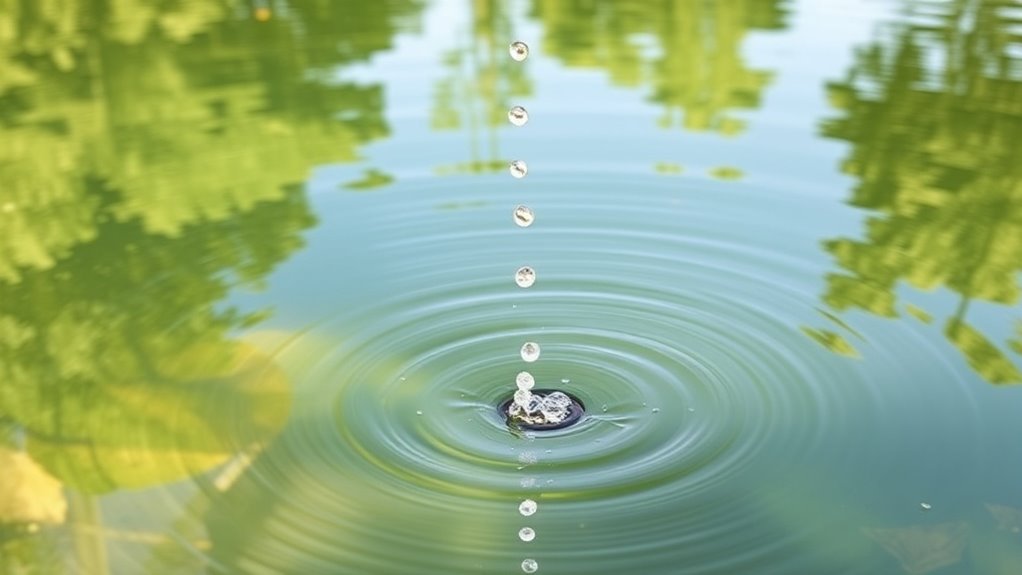
Aeration influences water pH primarily through gas exchange, where dissolved carbon dioxide (CO₂) escapes from the water into the air. As CO₂ leaves, it shifts the equilibrium, causing the water’s pH to rise. This process can quickly raise acidity levels, making the water less acidic without changing total alkalinity. When you aerate, you’re effectively removing the CO₂ that forms carbonic acid, which normally keeps the pH low. This process is supported by science, showing how gas exchange affects water chemistry.
- Think of it like popping a balloon—CO₂ escapes, and the water becomes less acidic.
- Aeration is like giving your water a surge of fresh air.
- The faster you aerate, the quicker CO₂ leaves.
- It’s a natural way to boost pH without adding chemicals.
- You’re simply helping the water reach a more neutral state.
Step-by-Step Guide to Implementing the Aeration Technique
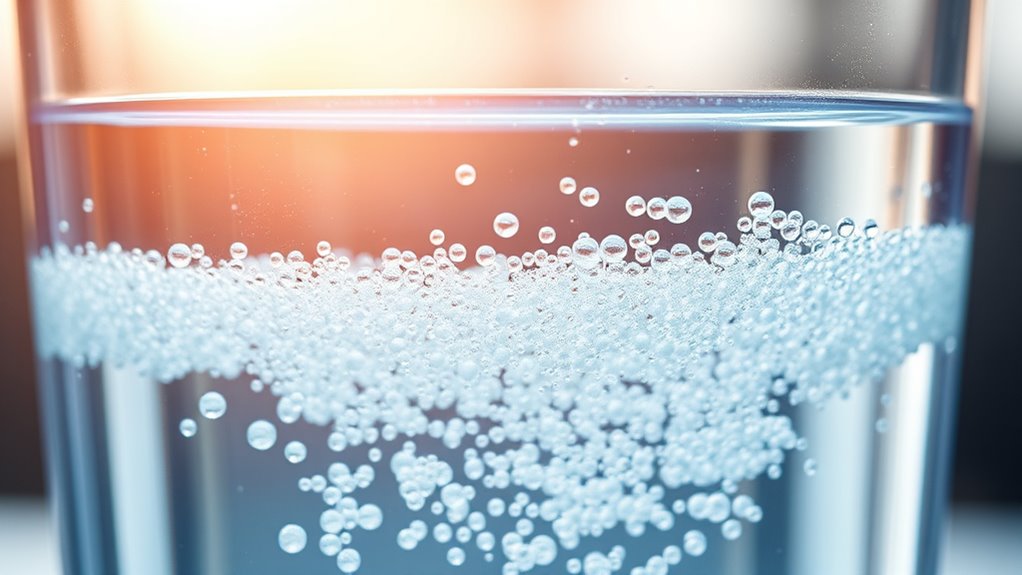
Start by preparing your water, ensuring it’s properly mixed and free of debris. Next, set up your aeration equipment, such as air stones or diffusers, in the water. Finally, run the aeration process steadily, making sure the gas exchange occurs effectively to raise the pH. Incorporating proper maintenance routines can help sustain optimal aeration results over time.
Prepare Your Water
Before you begin the aeration process, it’s important to prepare your water properly. Start by testing your current pH and alkalinity levels so you know where you’re starting. Remove any debris or floating particles that could interfere with aeration. Confirm your water temperature is within a suitable range, as extreme temperatures can affect gas exchange. If your water has high organic matter, consider pre-treating it to prevent odors or cloudiness. Finally, fill your container or setup with water at the right volume, making sure it’s accessible for aeration equipment. Proper preparation helps maximize oxygen exchange and ensures the process works efficiently. Additionally, understanding the composition of your water can help tailor the aeration process to achieve optimal pH levels. By paying attention to these details, you’ll set a solid foundation for raising your pH without impacting TA.
Execute the Aeration Process
To effectively execute the aeration process, you need to set up your equipment correctly and guarantee proper water flow. Start by positioning your aerator in a central location, ensuring it’s fully submerged. Adjust the flow rate so the bubbles create turbulence without splashing excessively. Keep the water moving steadily to maximize oxygen exchange and prevent stagnation. Run the aerator continuously for 24 to 48 hours, depending on your water volume. Monitor the process regularly, checking for uniform bubbling and consistent movement. Avoid turning off or adjusting the equipment prematurely, as this can reduce aeration efficiency. By maintaining ideal flow and proper placement, you’ll effectively increase dissolved oxygen levels and facilitate the pH adjustment without impacting total alkalinity. Additionally, understanding ventilation considerations can help optimize overall water quality and safety during the process.
Equipment Needed for Effective Aeration in Aquariums
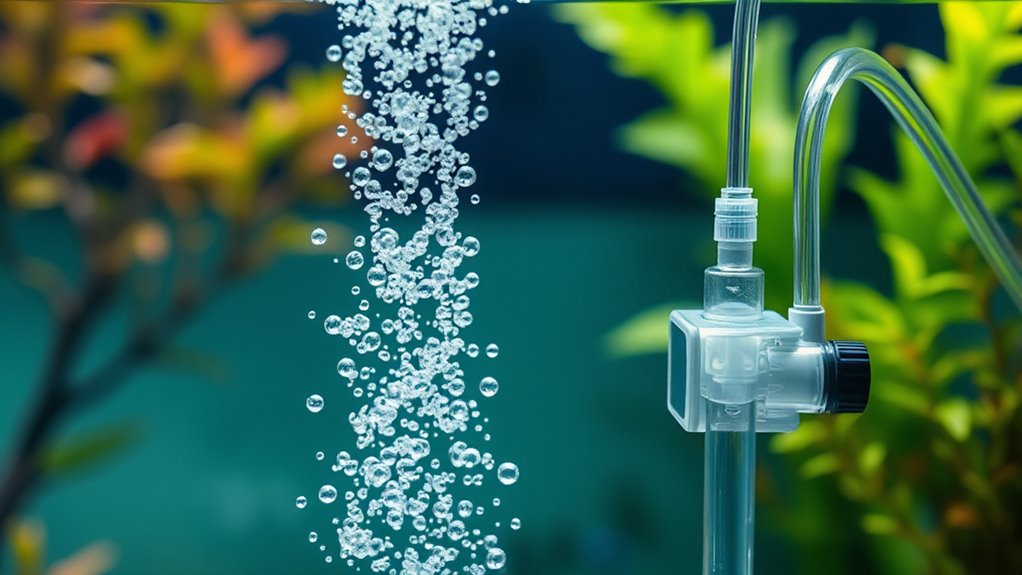
Effective aeration in aquariums relies on the right equipment to guarantee proper oxygen exchange and water circulation. The equipment you choose impacts how well your tank maintains stable conditions and supports healthy fish. Essential items include a reliable air pump, which ensures continuous airflow; air stones or diffusers to distribute oxygen evenly; tubing to connect components; check valves for safety; and a control valve to regulate airflow. Investing in quality equipment prevents malfunctions and provides consistent aeration. Remember, the goal is to maximize oxygen transfer without disturbing the water’s stability. With the right setup, you’ll create an environment that promotes healthy swimming and helps maintain ideal pH levels. Proper equipment makes all the difference in achieving effective and safe aeration.
Monitoring Water Parameters During Aeration
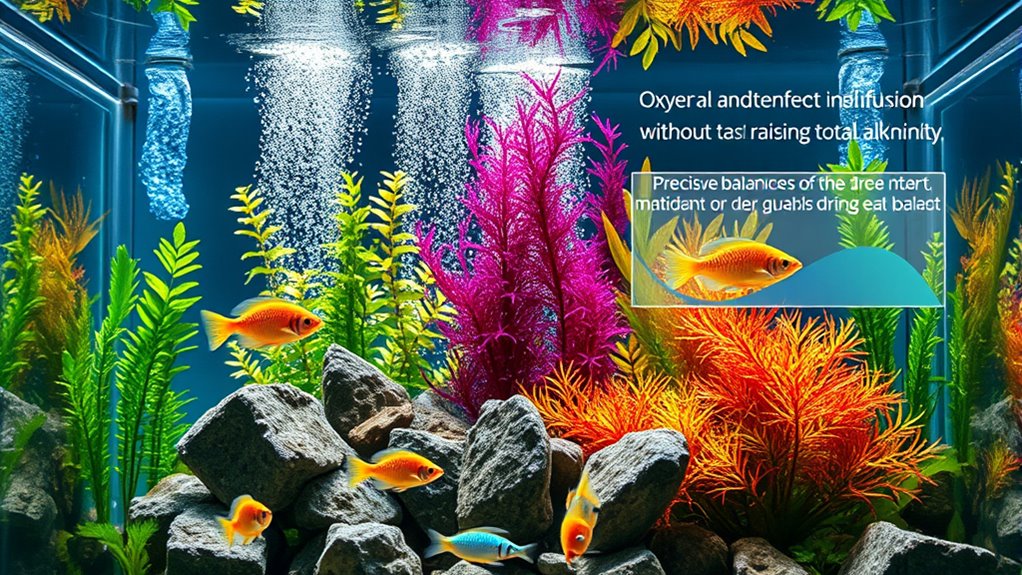
Monitoring water parameters during aeration is vital to guarantee your adjustments support a stable and healthy environment. As you aerate, keep a close eye on pH levels to ensure they rise gradually without overshooting. Regularly test alkalinity (KH) to confirm it remains stable, preventing unwanted fluctuations. Tracking dissolved oxygen levels helps you understand how aeration impacts the water, making certain you’re not causing stress to aquatic life. Use reliable test kits or digital meters for accurate readings. Record your results consistently to observe trends and make informed adjustments. By monitoring these parameters, you’ll be able to fine-tune your aeration process effectively, raising pH safely without disturbing the overall water chemistry. This proactive approach maintains a balanced, thriving aquatic environment.
Common Mistakes to Avoid When Using Aeration for Ph Adjustment

While aeration can gently raise pH levels, many aquarists make the mistake of overdoing it, which can lead to unstable water chemistry. Excessive aeration can cause pH swings that stress your aquatic life. To avoid this, keep these mistakes in mind:
- Over-aerating for long periods without monitoring
- Ignoring the impact on dissolved oxygen levels
- Using inconsistent aeration devices or settings
- Neglecting to test water parameters regularly
- Relying solely on aeration without other pH stabilization methods
These errors can destabilize your tank’s environment, making it harder to maintain stable conditions. Use aeration thoughtfully, monitor water parameters frequently, and avoid aggressive adjustments to keep your aquatic ecosystem healthy.
Benefits of Using Aeration to Maintain Stable Water Conditions
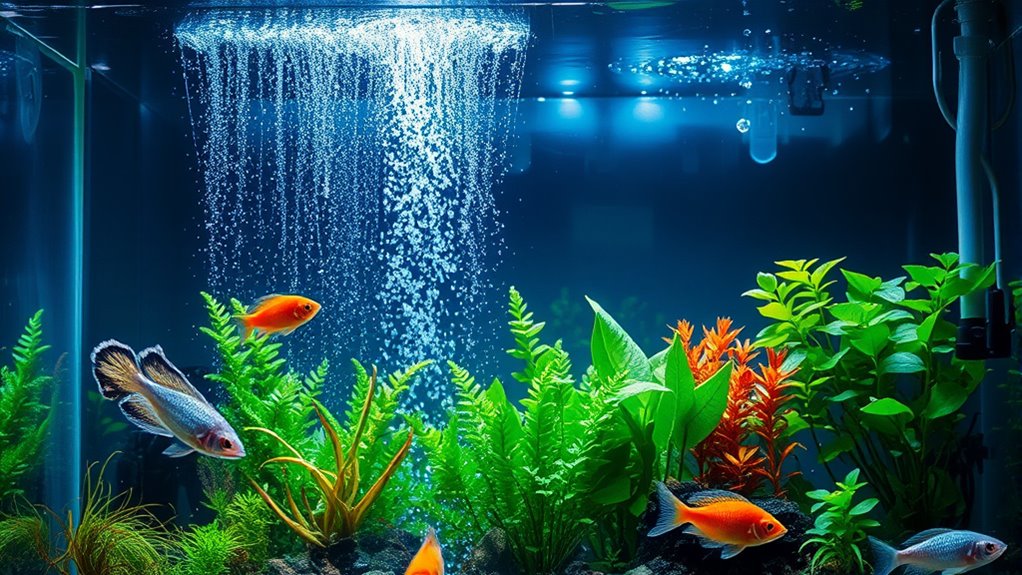
Aeration plays a crucial role in maintaining stable water conditions by continuously circulating and exchanging gases within your aquarium. This process helps prevent oxygen depletion, supporting healthy fish and beneficial bacteria. By promoting consistent oxygen levels, aeration reduces the risk of harmful fluctuations that can stress aquatic life or cause unstable pH and TA. It also aids in removing dissolved waste gases, keeping water clarity high and preventing the buildup of toxic substances. Additionally, aeration encourages even temperature distribution, avoiding hot or cold spots that can disturb the environment. With steady oxygen exchange, your aquarium remains balanced, making it easier to maintain ideal water chemistry over time. Overall, aeration simplifies managing water stability and promotes a healthier, more resilient aquatic ecosystem.
Tips for Optimizing Aeration for Different Aquarium Setups
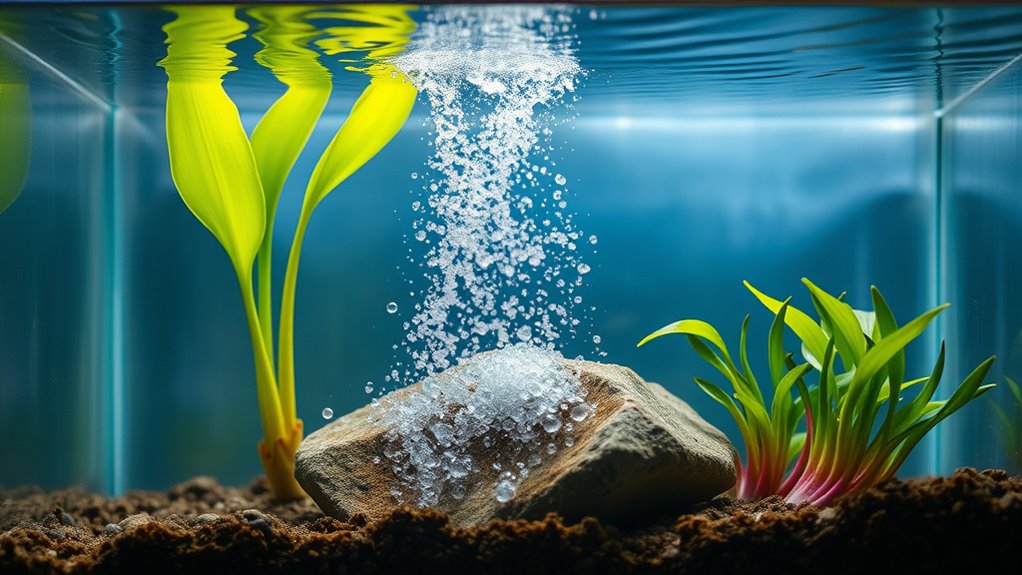
Optimizing aeration depends on your aquarium’s size, stock, and setup, so tailoring your approach guarantees the best results. For smaller tanks, gentle aeration with a sponge filter often suffices, preventing unnecessary stress. Larger or heavily stocked tanks may need stronger air pumps and diffusers to ensure oxygen reaches all areas. If you have live plants, avoid over-aerating, which can strip CO2 and hinder growth. For tanks with sensitive species, opt for adjustable aeration to prevent turbulence. Consider the placement of your air stones—position them away from delicate fish or plants for even oxygen distribution. Regularly monitor your water parameters and adjust airflow accordingly to maintain ideal conditions without disturbing your ecosystem.
Tailor aeration to your tank size and inhabitants for optimal aquatic health.
- Match aeration strength to tank size and inhabitants
- Use adjustable pumps for sensitive setups
- Place air stones strategically
- Avoid excessive turbulence around plants and fish
- Regularly test water for stability
Frequently Asked Questions
Can Aeration Permanently Raise Ph Levels?
No, aeration doesn’t permanently raise pH levels. It temporarily increases pH by removing carbon dioxide from the water, which reduces acidity. Once aeration stops and CO₂ re-enters the water, pH levels can drop back to their original levels. To maintain higher pH long-term, you’ll need to adjust alkalinity or add pH buffers. Aeration is a quick, temporary fix rather than a permanent solution.
Does Aeration Affect Other Water Parameters Besides Ph?
Yes, aeration can affect other water parameters besides pH. As you aerate, dissolved gases like oxygen increase, which can improve water clarity and promote beneficial bacteria growth. It may also help reduce dissolved carbon dioxide, impacting carbonate hardness indirectly. However, aeration isn’t a reliable method for directly altering parameters like alkalinity or hardness, so if you need precise control, consider other treatment options.
How Long Should Aeration Be Applied to See Effects?
You should aerate your water for about 24 to 48 hours to see noticeable effects on pH. Interestingly, aeration can increase pH by removing dissolved carbon dioxide, which accounts for up to 50% of pH changes. During this time, the gas exchange stabilizes, raising pH levels without considerably affecting total alkalinity. Keep monitoring your water, and adjust aeration duration if needed for ideal results.
Is Aeration Suitable for All Types of Aquariums?
Aeration is suitable for most aquariums, but you should consider your tank’s specific needs. If you have sensitive fish or delicate plants, excessive aeration might cause stress or disrupt water chemistry. For standard freshwater setups, aeration helps maintain oxygen levels and can aid in raising pH without affecting total alkalinity. Always monitor your tank’s conditions and adapt aeration accordingly to ensure a healthy environment.
What Are the Signs That Aeration Is Improving Water Quality?
You notice your fish become more active and their colors brighten after aeration improves water quality. For example, in a home aquarium, increased aeration can reduce ammonia spikes and stabilize pH levels. Signs include clearer water, fewer algae blooms, and healthier fish behavior. If these changes occur, it’s a good indication that aeration is effectively enhancing water quality, supporting a healthier environment for your aquatic life.
Conclusion
By mastering the aeration trick, you can raise your pH without boosting your total alkalinity, keeping your water chemistry balanced. Just remember, it’s not a one-size-fits-all solution—pay close attention to your water parameters and avoid common pitfalls. With patience and practice, you’ll be able to keep your aquarium stable and healthy. After all, when it comes to water chemistry, a little know-how can go a long way—so don’t let it slip through your fingers.
